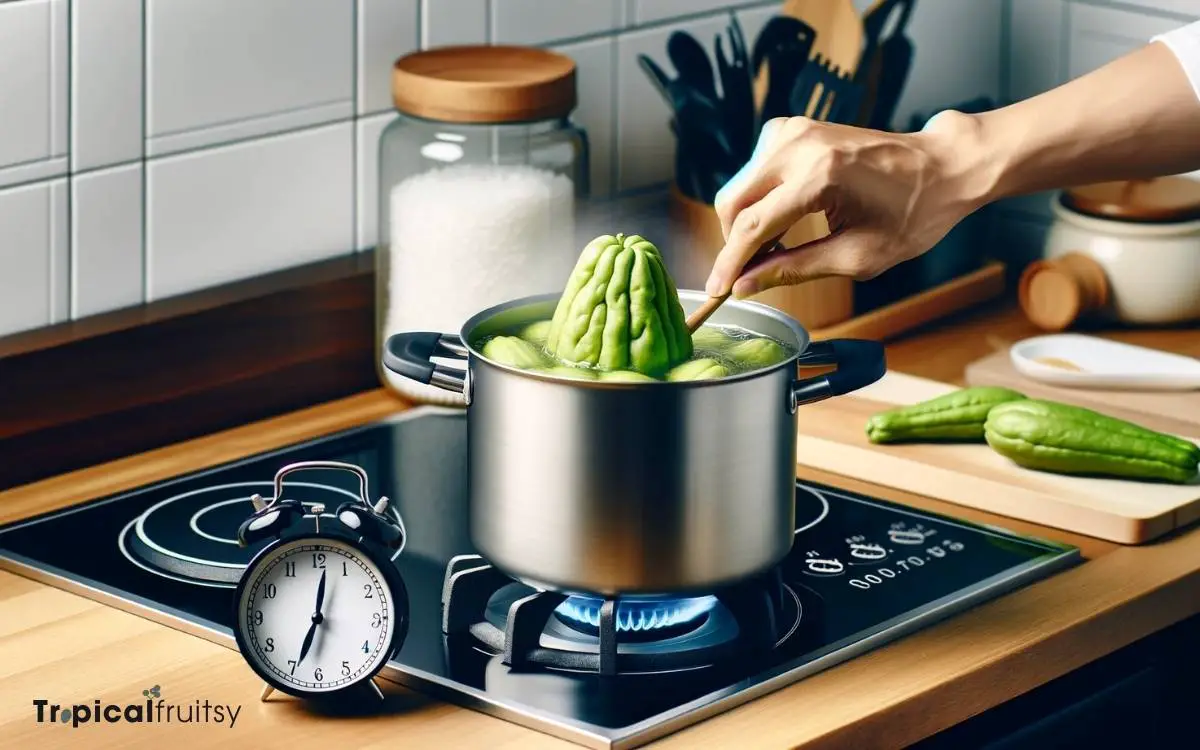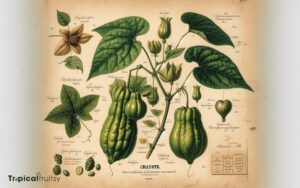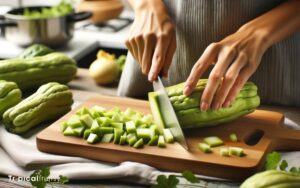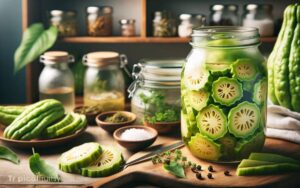How Long to Boil Chayote? 6 Easy Steps!
To properly boil chayote, bring a pot of salted water to a rolling boil, add the whole or cut chayote, and cook for 20 to 30 minutes or until tender.
Boiling chayote, a green, pear-shaped vegetable also known as mirliton or chocho, is a simple process. The cooking time can vary based on the size and how the vegetable is cut.
Here’s a quick guide to boiling chayote:
Remember that the boiling time is just a guideline and can depend on personal preference and the particular chayote’s size and maturity.
Perfectly boiled chayote becomes a versatile ingredient, blending well into soups, stews, or salads with its mild, crisp texture.

Key Takeaway
Step 1: Selecting the Perfect Chayote
Before we dive into the boiling process, let’s ensure we’re starting off with the best chayote by focusing on how to pick them from the bunch. We’re looking for firm, unblemished chayotes with a vibrant green hue.
They shouldn’t have any soft spots or signs of brown discoloration. A bit of prickle is normal, but it shouldn’t be overly spiny. Gently squeeze the chayote; it should feel sturdy in your hand, not yielding to the pressure.
Size doesn’t necessarily equate to quality, but medium-sized chayotes are often the sweet spot for both texture and flavor.
Once we’ve selected the prime candidates, we’re ready to move on. Now, let’s talk about preparing your chayote for boiling.
Step 2: Preparing Your Chayote for Boiling
Before we get our chayote into the pot, we’ll need to prepare it properly.
First, we’ll thoroughly wash and peel the skin off, ensuring there’s no dirt or residue left.
Then, we’ll cut it into even pieces, and if we prefer, we can remove the seed at this stage.
Wash and Peel
While preparing chayote for boiling, we’ll first need to thoroughly wash and peel them. This is crucial to remove any dirt or potential pesticides from the skin. Peeling is necessary as the skin can be tough and not particularly pleasant to eat after boiling.
Here’s a quick guide to help you through the process:
| Step | Description |
|---|---|
| Wash | Rinse under cold water to remove surface dirt. |
| Peel | Use a vegetable peeler or knife carefully. |
| Cut (optional) | Slice in half to remove the seed if desired. |
| Boil | Ready to be submerged in boiling water. |
Cut Into Pieces
Having washed and peeled the chayote, we’re now ready to cut it into pieces for boiling. To ensure even cooking, we’ll slice the chayote into uniform chunks.
We prefer using a sharp knife and a stable cutting board to avoid any accidents. It’s best to make lengthwise cuts, dividing the chayote into halves or quarters, depending on its size.
Then, we cut these sections into smaller, bite-sized pieces, making them perfect for stews or as a side dish.
Remember, the size of the pieces will affect the boiling time, so aim for consistency in your chopping. Once we’ve prepared our chayote, we move on to the next step in the cooking process.
Before we begin boiling, let’s consider whether we want to remove the seed.
Remove Seed (If Desired)
In preparation for boiling, we can opt to remove the chayote’s seed, especially if we’re aiming for a more tender bite throughout the dish. While the seed is edible, its removal can enhance the consistency of your recipe.
For those of us unfamiliar, the chayote seed is found at the fruit’s center, encased by the flesh. It is easily scooped out with a spoon once the chayote is halved.
Here’s a quick guide to seed removal:
| Step | Action | Tip |
|---|---|---|
| 1 | Halve the chayote lengthwise | Use a steady cutting board |
| 2 | Scoop out the seed | A spoon or melon baller works well |
| 3 | Discard or set aside | Save the seed for planting or other uses |
After the seed is removed, the chayote is ready to be boiled to perfection.
Step 3: How Much Water Is Needed
When boiling chayote, we need to consider the amount of water that will cover the fruit entirely without wastage. Our experience dictates that a healthy water-to-chayote ratio is essential to ensure even cooking.
We’ll also take into account the pot size and minimal water requirement to achieve the perfect texture.
Water-to-Chayote Ratio
We’ll need an ample amount of water to fully submerge the chayote for boiling, ensuring even cooking throughout.
Here’s a simple guide:
For a whole chayote:
- Use at least 2 quarts of water for one medium-sized chayote.
- For sliced or cubed chayote:
- A ratio of 3:1, water to chayote, should suffice.
Remember, these are starting points. It’s crucial to adjust based on the size and number of chayotes you’re cooking.
Too little water could result in unevenly cooked chayote, while too much simply extends the boiling time needlessly.
With the water-to-chayote ratio squared away, let’s consider how the size of your pot can affect the boiling process.
Pot Size Considerations
How do we choose the right pot size to ensure our chayote boils perfectly without wasting water or overcrowding the pot?
First, consider the number of chayotes you’re planning to cook. For a single chayote, a medium-sized pot that holds about 2 quarts is sufficient.
If you’re boiling multiple chayotes, you’ll need a larger pot, ensuring there’s enough room for water to circulate freely around each piece.
The key is to use enough water to cover the chayotes by at least an inch, but not so much that it takes a long time to reach a boil.
We typically recommend about 1.5 to 2 quarts of water per chayote. This ratio allows for even cooking and prevents unnecessary water usage.
Minimal Water Requirement
To ensure our chayote cooks evenly, we’ll need a water volume that’s just enough to submerge the vegetable without excess. This minimal water requirement is essential to achieve the perfect texture without wasting resources.
Here’s what we should consider:
Pot size:
- For a medium pot, typically 1-2 quarts of water suffices.
- For larger pots, adjust proportionally.
Chayote size:
- Small to medium chayotes may need less water.
- Larger pieces might require slightly more to be fully covered.
Aim for just enough water to cover the chayote by about an inch, ensuring it remains submerged during the boiling process.
By optimizing the water level, we not only cook the chayote properly but also conserve water and energy.
Step 4: Boiling Time for Chayote
Although chayote can vary in size and thickness, we typically find that boiling it for 20 to 30 minutes is sufficient for it to become tender.
We’ve learned that the key to perfectly boiled chayote lies in maintaining a consistent simmer. This ensures even cooking and prevents the chayote from becoming mushy.
It’s crucial to start with cold water and bring the pot to a boil together with the chayote. This gradual heating helps cook the chayote evenly.
Don’t forget to add a pinch of salt to enhance its subtle flavor. Once boiling, reduce the heat to a gentle simmer.
After 20 minutes, check for tenderness with a fork. If it’s not quite there, continue boiling and check every few minutes until it reaches the desired consistency.
Testing Chayote for Doneness
When do we know the chayote is perfectly cooked?
- Testing the chayote involves a few simple steps:
- Use a fork or the tip of a knife to gently pierce the chayote.
- Look for a texture that’s tender yet slightly firm, similar to a cooked potato.
We’ve found that the perfect chayote yields to pressure without resistance but maintains its shape without falling apart. It’s a delicate balance, but with a little practice, we can master the art of gauging doneness.
After boiling, let the chayote sit for a moment before testing; this allows the heat to distribute evenly. Remember, each chayote may cook slightly differently due to size and ripeness, so it’s wise to test each piece individually.
Step 5: Draining and Cooling Process
After boiling the chayote to perfection, we’ll need to drain the water and allow them to cool before handling. It’s best to use a colander for this task, ensuring the water drains away quickly and efficiently.
We’ll give the chayote a gentle shake to remove excess water, which helps speed up the cooling process. If we’re in a rush, we can rinse them under cold water to bring the temperature down faster.
Once they’re cool enough to handle, we can proceed with peeling and slicing the chayote as desired. Remember to handle them with care, as they can still retain some heat internally.
With the chayote drained and cooled, we’re now ready to delve into enticing serving suggestions for boiled chayote.
Step 6: Serving Suggestions for Boiled Chayote
Having boiled chayote to tender perfection, we can now explore various delicious ways to incorporate it into our meals. The versatility of this gourd makes it a delightful addition to both savory and sweet dishes.
As a savory side:
- Tossed in a salad with a citrus vinaigrette
- Mixed into a stir-fry with other vegetables and your choice of protein
- In sweet variations:
- Drizzled with honey and a sprinkle of cinnamon
- Pureed into a soup with a touch of cream for richness
Boiled chayote also complements grains like rice or quinoa beautifully. Whichever way we choose to serve it, let’s ensure it’s seasoned well to bring out its unique, subtle flavor.
Enjoy experimenting with this nutritious and tasty vegetable!
Conclusion
We’ve steered you through the rolling waters of boiling chayote, much like a captain navigating a ship to safe harbor.
Just as a single lighthouse guides sailors, our simple rule of thumb—20 to 30 minutes to tender perfection—illuminates your culinary journey.
Now, with chayote perfectly tender, we’re ready to drain, cool, and serve this versatile vessel of flavor.
Bon appétit, fellow food explorers!






